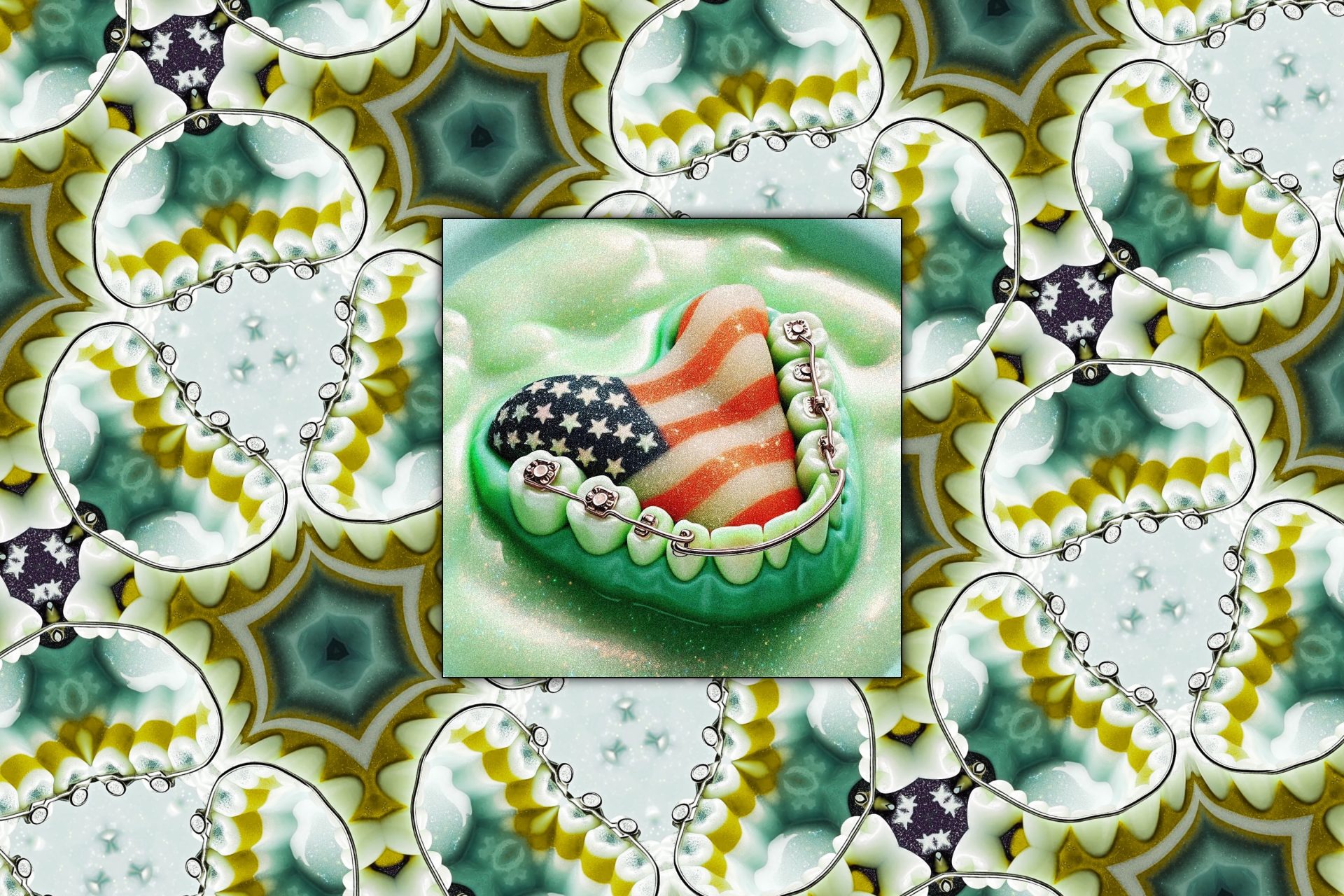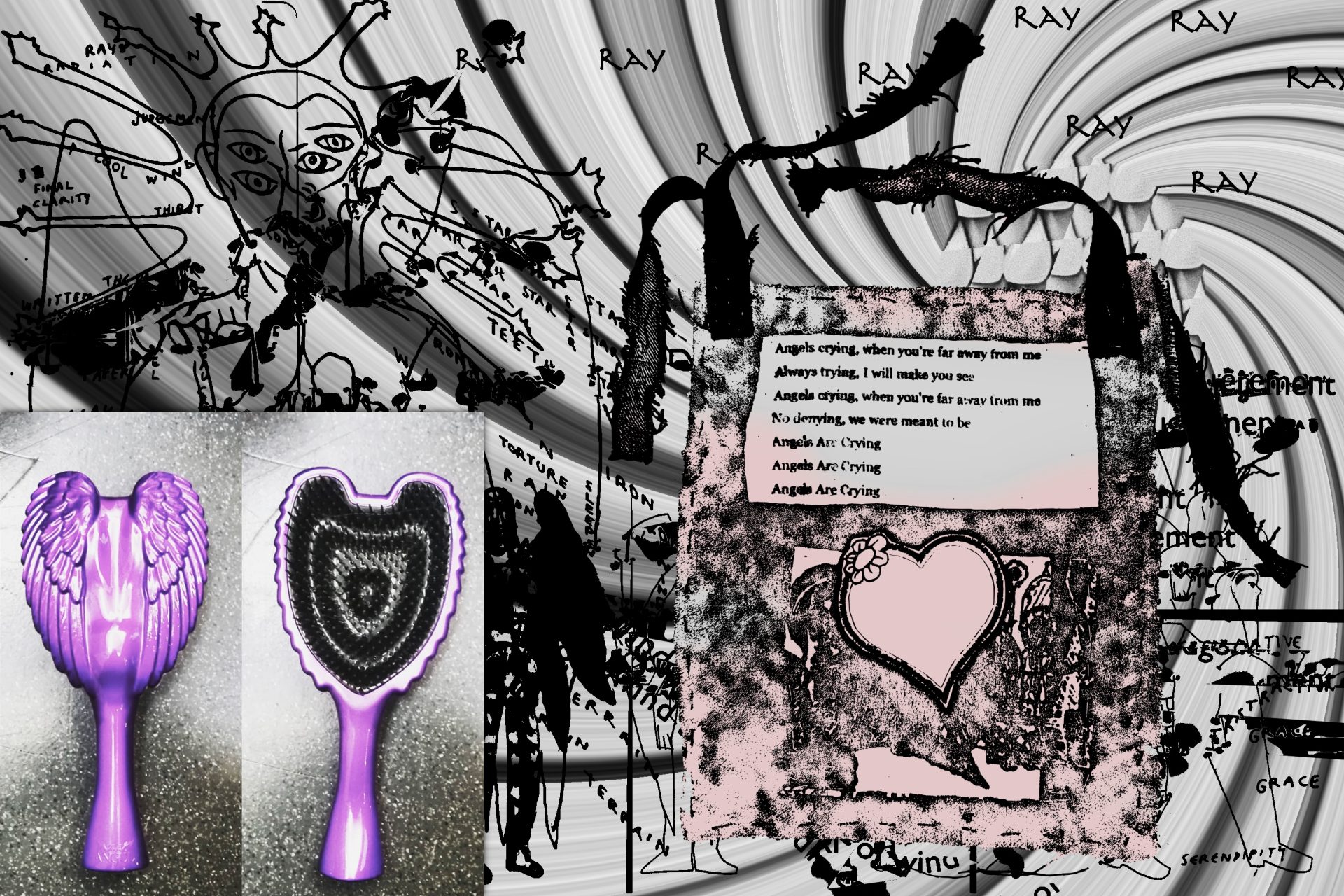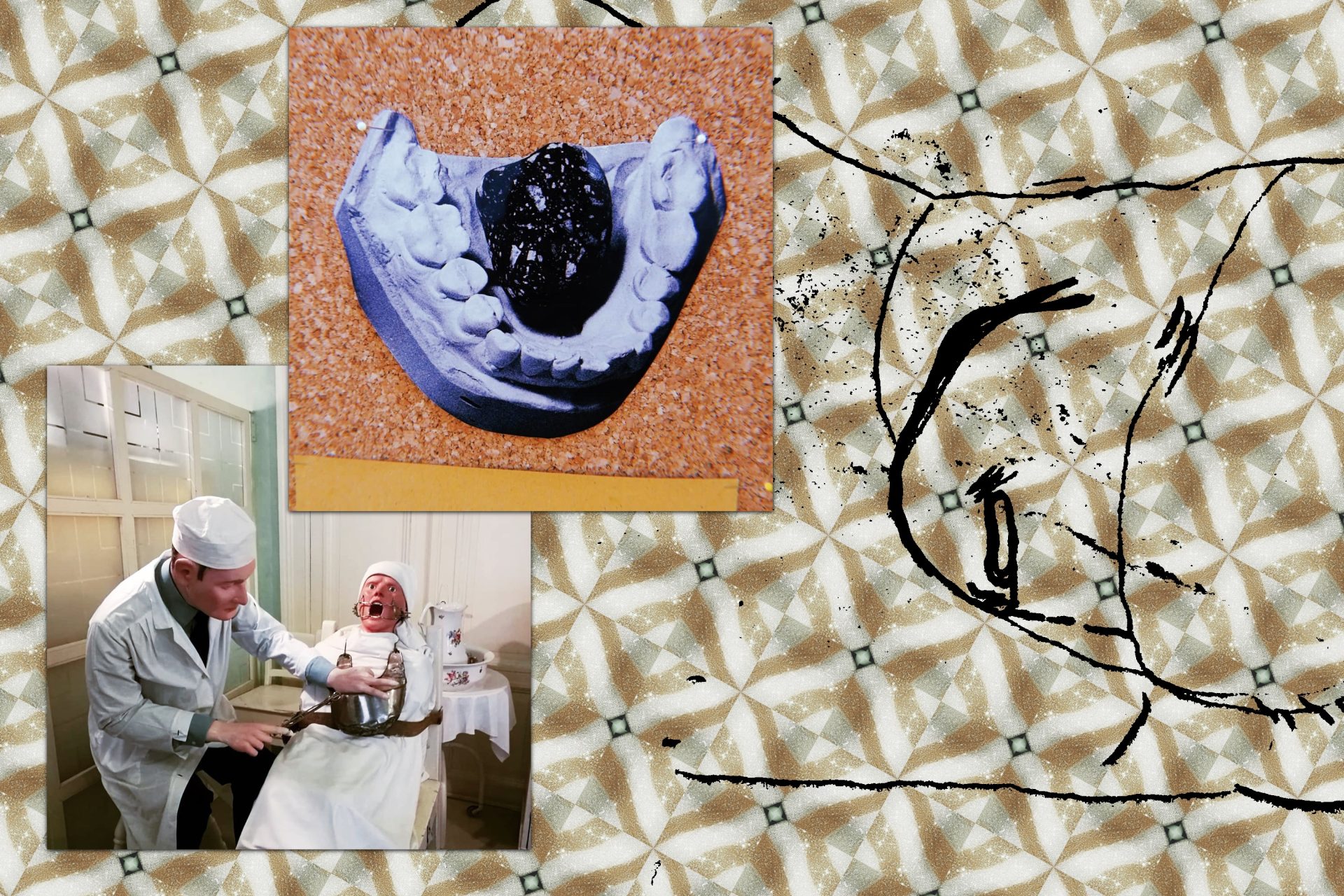Valentinas Klimašauskas talks to Jaakko Pallasvuo and Avocado Ibuprofen about switching chairs with a dentist, automating the viewer, and social media, among other things.
First of all, who do I have the pleasure to talk to, Jaakko Pallasvuo (JP) or Avocado Ibuprofen (AI)?
We’re both here. We’re looking for Dr Klimašauskas’ surgery. We need to get our wisdom teeth pulled out.
This is the right door then. Sitting in the dentist’s chair, anaesthetised, with my mouth wide open under the bright lights, and someone’s hands and instruments in there, I had helpful visions about how to move on with my doctoral thesis. How do you feel in the patient’s chair? Does it help you move on with your art practice?
I used to go to a dentist who had an unusually friendly and affirming way to encounter her patients. It made the experience of receiving treatment less daunting and alienating. I would lie down on the chair, and they’d put those funny sunglasses on my face, and then I would see it, past the bright lights that they were aiming at my mouth. The dentist had put this very intense painting on the ceiling of the surgery, and I would have no choice but to look at it during the appointment. I remember there were these detached Surrealist eyes floating around on the canvas, and there were sharp, jagged pieces of colourful glass glued to the textile. When I looked at the painting, I thought about what it would feel like to chew on glass, to really bite down on it.
For a long time I’ve been thinking about this artwork, maybe more of a play, that would take place at a theatre festival. It would consist of a dentist’s chair on stage, and a dental hygienist ready to scrape calculus off people’s teeth. A volunteer from the audience would get this treatment for free, and the rest of the audience would be allowed to watch. Maybe the inside of the mouth would be projected on to large screens so that people could see what was going on in sufficient detail. The artwork would reflect on the notion of ‘care’ that occupies a lot of thought-space in the art world at the moment, and would also be a partial remedy for how difficult it is to get a public dental health appointment in Helsinki right now. The work never came to be, and instead I ended up writing a monologue for Teo Ala-Ruona (https://teoalaruona.net/) about a dentist who moves to a new city with the hope of becoming an artist.
 Why would a dentist want to become an artist? One of my friends made the reverse move, from acting to dentistry. Also, isn’t moving from dentistry to an artistic field like moving to another world, so you don’t need to change cities? I want to know more about the script.
Why would a dentist want to become an artist? One of my friends made the reverse move, from acting to dentistry. Also, isn’t moving from dentistry to an artistic field like moving to another world, so you don’t need to change cities? I want to know more about the script.
The starting point of the monologue was tied to my being so captivated by fantasies of starting over. I’ve been a professional artist for more than a decade now, and every year (usually in the spring), I think long and hard about my choices and possible exit strategies. But I’m still here, replying to this question from the position of an artist.
A friend of my family who was a practising dentist once grilled me about why I had ended up doing what I did. Maybe my art practice seemed particularly vague and unreasonably privileged at the time. I explained to her that I saw what I did as a real-time strategy game. Art was a game to me. I had just returned to Helsinki for a visit from London. She told me I should get a job in a factory and learn about real life.
Then she started praising her own field: how healthcare was profoundly meaningful, because it was so needed, because it made people’s quality of life better, and extended life itself. The conversation led to an interesting dead end when someone else pointed out that a society where everyone worked in healthcare would be neither viable nor desirable. Many years later, though, I can see how Finland could become that: a country full of (increasingly elderly) patients and their carers, and a small elite class of tech and business workers making the money to keep going these processes of suffering, healing, birth and death. Maybe curators and artists would have to choose whether to join the carers or the patients.
 You mention a few problematic aspects of the art field related to the so-called freedom or autonomy of art, or being an artist, and art’s impact on society. As our societies are becoming automatic or even algorithmic, certain automatisms also pervade the sphere that used to be seen as mostly creative, contemporary art. Can I ask you what your thoughts are about this specific condition of automatism versus creativity, especially against the background of communicating your work on social networks?
You mention a few problematic aspects of the art field related to the so-called freedom or autonomy of art, or being an artist, and art’s impact on society. As our societies are becoming automatic or even algorithmic, certain automatisms also pervade the sphere that used to be seen as mostly creative, contemporary art. Can I ask you what your thoughts are about this specific condition of automatism versus creativity, especially against the background of communicating your work on social networks?
And so life is reckoned as nothing. Habitualisation devours work, clothes, furniture, one’s wife, and the fear of war. ‘If the whole complex lives of many people go on unconsciously, then such lives are as if they had never been.’ And art exists so that one may recover the sensation of life; it exists to make one feel things, to make the stone stony.
Viktor Shklovsky, ‘Art as Technique’ (1917)
Automation does seem more of an issue of perception and repeated functioning in the world, rather than (necessarily) a problem to do with the creation of artworks. I feel there’s an abundance of interesting material, and a hugely limited capacity to see it properly or respond to it in any way.
People just seem tired, slowly burned out by perpetual ecological, economic and political crises, and by the cognitive demands of knowledge work, which often includes the unpaid work of reproducing oneself as a subject on social media platforms. It seems harder and harder to ask that people would voluntarily have their ways of seeing challenged or inconvenienced by all this difficult art, when there is no solid ground to stand on and contemplate an image.
I think this sense of general fatigue, and impatient, habitual perception, has led the art world to move its goalposts, and to push artists to thematise, clarify and explain their work more and more. Frustratingly, art can never be clear enough. The problem is compounded by the creation of an ultra-precarious administrative class of freelance curators who also seem unfortunately quite involved in this push for art to name itself, to give itself an outline, to be anchored in the autobiography and ‘position’ the artist is supposed to inhabit in some valid, undeniable way. Images melt into the air, and only a reference to lived experience can re-solidify them for the purposes of another radical, world-transforming biennial.
There’s been a lot of discussion lately about the automation of image and text production through AI tools. What I’m personally more interested in is the possibility of automating the viewer, the one tasked with appreciating all these creations. Attention is where the scarcity lies. I often dream about some kind of angelic, celestial figure, or machine intelligence (the difference might not matter?), that would be able to perceive the work I make in some more vertical, fuller way, removed from the transactional, flat, disappointing horizon of the professionalised ‘art world’ and quantified online interactions. This seems speculative and a bit silly, until one remembers the millennia of artful objects that have been created and put to use in establishing a link to the skies.
 Let’s talk about ‘automating the viewer’ in this so-called economy of attention. Could you expand on it? Do you think it is possible to perceive artwork as not a part of the art world, as not belonging to it?
Let’s talk about ‘automating the viewer’ in this so-called economy of attention. Could you expand on it? Do you think it is possible to perceive artwork as not a part of the art world, as not belonging to it?
What drives me is more the number of activities I want to continue (observing, writing and drawing) than the possible outcomes, and whether or not those outcomes would be considered artworks. I feel an affinity with many other people besides contemporary artists (illustrators, journalists, comedians, meme page admins, poets, filmmakers and designers come to mind). The will to act feels similar, and it’s a bit arbitrary what ends up being contextualised as art and what as some other thing? Maybe this is a kind of perceptive limitation I have, that I can’t see this circle of meaningful difference around the artwork any more.
I think many of the things I make and upload (I’ve been sharing images online for much longer than I’ve been a professional artist) do not get perceived as works of art. But they do get received as a kind of signal. A lot of the work I make that ends up in an art world context does not seem to be perceived, loved, critiqued or collected, even if it is correctly identified as an artwork. These solid works of art vanish in plain sight on the overlit walls of underfunded project spaces. I think most work produced by artists does not have room in the art world. It overflows into studio corners and basement storages, and ultimately to landfills, without ever receiving the care and consideration a narrow selection of works of art receives.
Sometimes when I do studio visits with art students, I can sense that there is this silent question the student wants an answer to hanging over the encounter, something like … am I good enough? Will this do? It’s a question that cannot be asked or answered, really. It’s probably a question that lingers in the fog of my own over-intellectualised doubt. Maybe the fantasy is that the outside eye of the automated viewer could be the one to put the matter to rest.
Do I understand correctly that you see these automated or algorithmic scenes or (social networks) platforms as more open for the distribution of your work, for example, than the art world, which is crowded with gatekeepers and other limitations, like white cube galleries, etc?
I don’t see this as a question where a binary choice (between social media platforms and the art world) would be possible, since the way the art system works is deeply entangled with how recommendation algorithms govern our attention. This is visible both in the flashes of political protest and scandal playing out at biennials, and in the work of the collectable, modellesque painters producing visually enticing wall objects depicting scenes from their aspirational social milieu.
It also seems to be behind the popularity of camera-friendly performance-based work that benefits from the algorithm’s preference for human faces, and from how we’ve all become so rehearsed at documenting ourselves and each other. For example, in the case of Young Boy Dancing Group, the performances appear as a sequence of living memetic images, and the audience members become nodes in a promotional network that receives, records and broadcasts the images as they are happening. It’s cute.
 To reflect on my circumstances: I don’t really see social media platforms as more open or ungoverned, but I guess it’s easier for me to perceive what the limits are, because they are somewhat more machinic and explicit than the informal, shadowy workings of the art system. I can’t say that I’m a fan of how social media operate, especially with the ongoing enshittification of the major platforms, but I also couldn’t say that I’m immune to the level of validation and praise I receive through Instagram (in contrast to my somewhat stale, soured relationship with the art world).
To reflect on my circumstances: I don’t really see social media platforms as more open or ungoverned, but I guess it’s easier for me to perceive what the limits are, because they are somewhat more machinic and explicit than the informal, shadowy workings of the art system. I can’t say that I’m a fan of how social media operate, especially with the ongoing enshittification of the major platforms, but I also couldn’t say that I’m immune to the level of validation and praise I receive through Instagram (in contrast to my somewhat stale, soured relationship with the art world).
My main form of interaction with art institutions is that I receive dozens of rejections every year to my applications for residencies, exhibition opportunities and public or private funding (the problem is heightened in the Nordic context, where open calls are used as a one-size-fits-all solution for anything). I don’t have a gallerist, and my work is not really being collected. Recent meetings with curators have resulted in mutual confusion and melancholy, because it is difficult for me to explain what I do, and for others to grasp it or see any value in it.
Of course, there are also good encounters and invitations that I should really be more grateful for, but ever since the pandemic it feels like the negative side of the art game has been more emphasised, and the positive side is faint or vanishing, while my Instagram account has really taken flight somehow. Maybe it’s not really a matter of a conscious decision, but an amoeba-like drifting towards warmer currents. Like I’m on social media because users tell me they want me to be there?
Maybe a more material way to describe the shift would be to think of inflation and rising real estate costs, and how they’ve coincided with a lack of investment in culture and art in a long period of austerity politics, and how at the same time information technology and virtual space have never been cheaper and more widely available.
Social media doesn’t pay for the most part (or users are left to find their own monetisation schemes), and it’s really stupid to work for free for Instagram so that Meta can gather the profits, but at least the tools, storage and circulation of digital images and texts are very, very affordable. A fairly decent PC laptop might cost the same amount of money as one month of studio rent, or much less than shipping a painting, a circumstance which would have been unthinkable twenty years ago.
How would Avocado Ibuprofen introduce Jaakko Pallasvuo to our readers?
A signal does not necessarily mean that you want to be located or described. It can mean that you want to be known as Unlocatable and Hidden. This contradiction can drive the ‘I’ in the lyrical poem into a series of techniques that are the reverse of the usual narrative movements around courage, discipline, conquest and fame.
Fanny Howe, Night Philosophy, p. 98
Jaakko Pallasvuo is a Finnish artist recognised for his multidisciplinary approach, incorporating drawing, painting, video and performance. His work delves into the themes of identity, digital culture, and the art world’s dynamics, often using humour and irony. Pallasvuo has exhibited his work internationally, reflecting the global relevance of his themes. Known for his collaborative projects, he works with other artists across various disciplines. Additionally, Pallasvuo maintains an active online presence on platforms like Tumblr and Instagram, where he shares his work and engages with a broad audience, enhancing the accessibility and impact of his art.
ChatGPT (when asked for a 100-word answer to the question ‘Who is Jaakko Pallasvuo?’)
Valentinas Klimašauskas (b. 1977, Lithuania) is a curator and writer. Recently, he cocurated the Lithuanian pavilion at the Venice Biennial 2024 (with João Laia, artists: Pakui Hardware and Marija Teresė Rožanskaitė). Klimašauskas is the author of “Telebodies” (Mousse Publishing, 2024), “Oh, My Darling & Other Rants” (The Baltic Notebooks of Anthony Blunt, 2018), “Polygon” (Six Chairs Books, 2018), and “B” (Torpedo Press, 2014).
More info at: https://selectedletters.lt






























